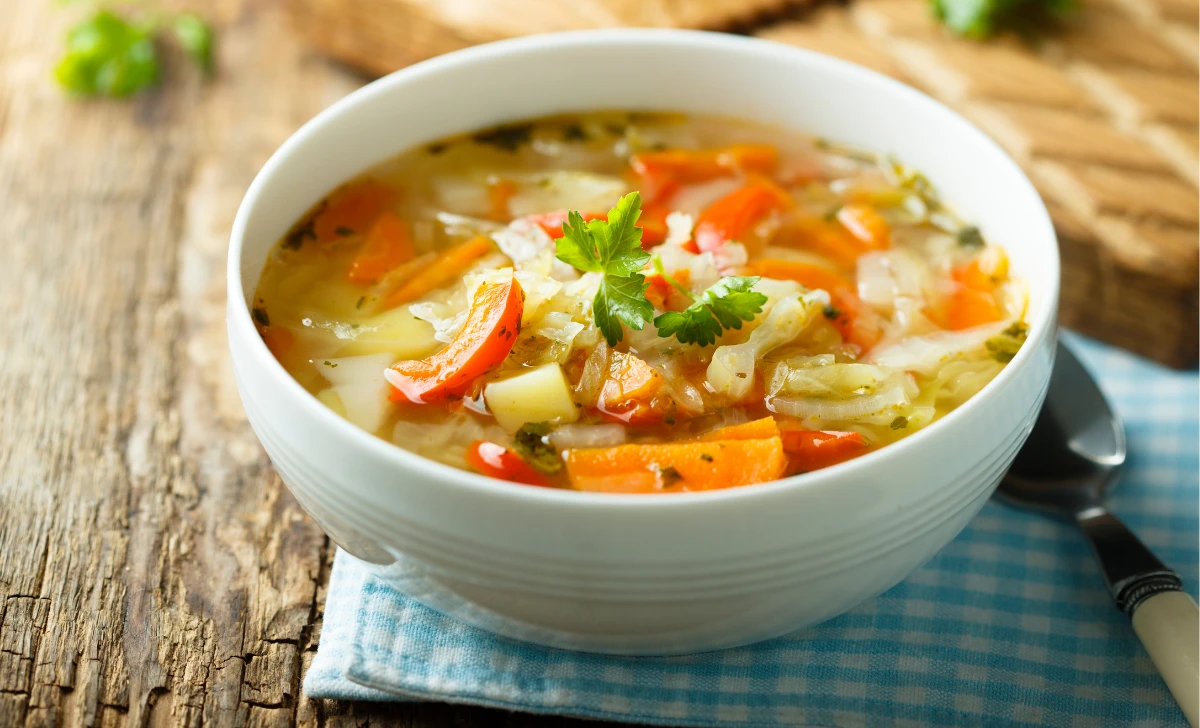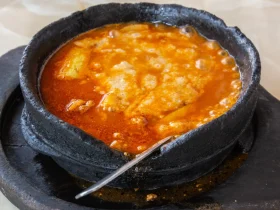Are you in the mood for a comforting and hearty meal that not only tastes fantastic but also provides essential nutrients? Look no further! In this article, we will delve into the delightful world of vegetable soup recipes. Whether you’re a seasoned chef or a novice in the kitchen, this easy-to-follow guide will help you create a scrumptious vegetable soup that will please your taste buds and nourish your body.
[ez-toc]
History
Vegetable soup has a rich history that spans across cultures and centuries. The concept of combining vegetables and broth to create a nourishing and flavorful dish has been practiced for thousands of years. Let’s explore the fascinating history behind the beloved vegetable soup recipe.
Ancient Origins
The origins of vegetable soup can be traced back to ancient civilizations, where the use of vegetables in cooking was prevalent. Ancient Egyptians, Greeks, and Romans valued the nutritional benefits of vegetables and often prepared soups using various ingredients available to them.
In ancient Egypt, vegetable soups were commonly consumed, particularly by the lower classes. These soups often consisted of ingredients such as onions, garlic, leeks, and herbs, cooked in water or broth. Vegetables were abundant in the fertile lands of the Nile, making them an essential part of the Egyptian diet.
Medieval Europe and the Renaissance
During the Middle Ages, vegetable soups became popular across Europe. In monasteries, vegetable-based meals were consumed during fasting periods, and soup was a common choice due to its simplicity and nourishing qualities.
With the discovery of the New World in the 15th century, European cuisine experienced a revolution. A wide variety of vegetables, such as potatoes, tomatoes, carrots, and bell peppers, were introduced, enriching the flavors and ingredients used in vegetable soups.
Development of Culinary Techniques
In the 18th and 19th centuries, advancements in culinary techniques and the availability of ingredients further refined the art of making vegetable soup. Cookbook authors and chefs began documenting recipes that showcased the versatility of vegetable soups and encouraged creativity in the kitchen.
As societies shifted towards industrialization, canned vegetable soups gained popularity due to their convenience and long shelf life. However, many people still preferred homemade vegetable soups for their freshness and personalized flavors.
Modern Vegetable Soup
In recent years, there has been a renewed interest in vegetable-based diets and a focus on health-conscious eating. Vegetable soup has become a staple in many households, admired for its ability to incorporate a wide range of vegetables, promote wellness, and reduce food waste.
Chefs and home cooks alike experiment with diverse combinations of vegetables, herbs, and spices to create unique and delicious soup recipes. Vegetable soup variations can be found in cuisines around the world, reflecting the cultural diversity and culinary creativity of different regions.
Time
| Step | Time |
|---|---|
| Preparation: Chopping and Dicing | 15 minutes |
| Sautéing the Aromatics | 10 minutes |
| Adding the Vegetables and Broth | 5 minutes |
| Seasoning to Perfection | 2 minutes |
| Simmering for Flavor Infusion | 30 minutes |
| Total Time | 62 minutes |
Note: The total time includes the individual step times and may vary based on personal cooking speed and preferences.
Ingredients
| Ingredients | Quantity |
|---|---|
| Carrots | 2 |
| Celery stalks | 2 |
| Onion | 1 |
| Garlic cloves | 2 |
| Potatoes | 2 |
| Tomato | 1 |
| Green beans | 1 cup |
| Cabbage | 1 cup |
| Vegetable broth | 4 cups |
| Olive oil | 2 tablespoons |
| Bay leaves | 2 |
| Thyme leaves | 1 teaspoon |
| Salt | To taste |
| Black pepper | To taste |
| Fresh parsley | For garnish |
Please note that these quantities are estimated for a 2-person serving and can be adjusted according to personal preferences.
Directions
Preparation: Chopping and Dicing
- Gather the Ingredients: Collect all the required ingredients for the vegetable soup recipe.
- Prepare the Vegetables: Peel and chop the carrots into bite-sized pieces. Dice the celery stalks, onion, and garlic cloves. Peel and dice the potatoes. Chop the tomato. Trim the ends of the green beans and cut them into small segments. Shred the cabbage.
Sautéing the Aromatics
- Heat the Olive Oil: In a large pot or Dutch oven, heat the olive oil over medium heat.
- Sauté the Aromatics: Add the diced onion and minced garlic to the pot. Sauté them until they become fragrant and the onion turns translucent.
Adding the Vegetables and Broth
- Add the Chopped Vegetables: Put the chopped carrots, celery, potatoes, tomato, green beans, and shredded cabbage into the pot with the sautéed aromatics. Stir them well to combine.
- Pour in the Vegetable Broth: Add the vegetable broth to the pot. Make sure the vegetables are fully submerged in the broth.
Seasoning to Perfection
- Add the Seasonings: Toss in the bay leaves and sprinkle thyme leaves into the pot. Season with salt and black pepper to taste.
Simmering for Flavor Infusion
- Bring to a Boil: Increase the heat to high and bring the soup to a boil.
- Reduce to Simmer: Once the soup is boiling, reduce the heat to low and let it simmer for about 30 minutes, or until the vegetables are tender and flavors meld together.
Serving and Garnishing
- Remove Bay Leaves: Before serving, remove the bay leaves from the soup and discard them.
- Garnish and Serve: Ladle the vegetable soup into bowls. Garnish each serving with fresh parsley.
Enjoy your delicious and nutritious vegetable soup!
Equipment Required
Nutrition Information
| Nutrition Information | Per Serving |
|---|---|
| Serving Size | 1 bowl (estimated) |
| Calories | 200 |
| Total Fat | 6g |
| Saturated Fat | 1g |
| Trans Fat | 0g |
| Cholesterol | 0mg |
| Sodium | 800mg |
| Total Carbohydrate | 35g |
| Dietary Fiber | 8g |
| Sugars | 10g |
| Protein | 6g |
| Vitamin D | 0mcg |
| Calcium | 80mg |
| Iron | 2mg |
| Potassium | 600mg |
Note: The nutrition information provided is an estimate and may vary based on specific ingredients used and portion sizes.
Tips
- Consistent Chopping: Try to chop the vegetables into similar sizes to ensure even cooking throughout the soup.
- Sautéing for Flavor: Take your time sautéing the aromatics until they become aromatic and translucent. This step helps develop the flavor base of the soup.
- Broth Choices: If you prefer a stronger flavor, use a vegetable broth with herbs or spices. For a lighter taste, opt for a low-sodium vegetable broth.
- Customize with Seasonings: Feel free to add additional seasonings and herbs according to your taste preferences. Consider herbs like rosemary or oregano for added depth.
- Don’t Overcook: Keep an eye on the simmering time to avoid overcooking the vegetables. They should be tender but still retain some texture.
- Make it Hearty: To make the soup heartier, you can add cooked grains like quinoa or barley during the simmering stage.
- Spice it Up: For a bit of heat, add a pinch of chili flakes or a dash of hot sauce to give your vegetable soup a spicy kick.
- Serving Suggestions: Serve the vegetable soup with crusty bread, a sprinkle of grated cheese, or a dollop of sour cream for added flavor and texture.
Pros & Cons
| Pros | Cons |
|---|---|
| ✓ Easy to Prepare | ❌ Time-Consuming |
| ✓ Nutritious and Healthy | ❌ High Sodium Content |
| ✓ Versatile and Customizable | ❌ May Not Appeal to All Palates |
| ✓ Great Way to Incorporate Vegetables | ❌ Some Chopping Required |
| ✓ Suitable for Vegan and Vegetarian Diets | ❌ Not Suitable for Low-Carb Diets |
Conclusion
In conclusion, vegetable soup is a delightful and nutritious dish that brings together the goodness of various vegetables in a comforting bowl. With its easy preparation and versatility, it’s a recipe that can be enjoyed by everyone, whether you’re a seasoned cook or a beginner in the kitchen.
This vegetable soup recipe offers numerous benefits. It provides a convenient way to incorporate a variety of vegetables into your diet, promoting a balanced and healthy lifestyle. It is also highly customizable, allowing you to tailor it to your taste preferences and dietary needs.
By preparing this vegetable soup, you’ll be treating yourself to a flavorful and nourishing meal. The combination of fresh vegetables, aromatic herbs, and savory broth creates a harmonious blend of textures and tastes. Each spoonful offers a burst of flavors that will satisfy your palate and warm your soul.
Not only is vegetable soup a delicious choice, but it also offers a wide range of health benefits. Packed with vitamins, minerals, and dietary fiber, it supports overall well-being and can be part of a balanced diet. It is particularly suitable for those following vegan or vegetarian lifestyles.
So why not give this vegetable soup recipe a try? Gather your ingredients, follow the easy steps, and enjoy the comforting aroma that will fill your kitchen. Whether it’s a cozy weeknight dinner or a gathering with loved ones, vegetable soup is a versatile option that is sure to impress.
Remember to get creative with variations, add your favorite seasonings, and make it your own. Let this recipe be a canvas for your culinary exploration. Discover the joy of preparing a homemade soup that warms your heart and nourishes your body.
Facts
- 🌱 Fact 1: Ancient Origins 🌍
- Did you know that vegetable soup has been enjoyed for centuries? Its roots can be traced back to ancient civilizations such as Egypt, Greece, and Rome. People throughout history recognized the value of vegetables and their ability to create nourishing and delicious soups.
- 🍲 Fact 2: Medieval Monastery Meals 🏰
- During the Middle Ages, vegetable soups gained popularity in monasteries. These institutions used vegetable-based meals, including soups, during fasting periods. The simplicity and nutritional benefits of vegetable soup made it a common choice among monks and nuns.
- 🚢 Fact 3: New World Discoveries 🌎
- The discovery of the New World in the 15th century had a profound impact on vegetable soup recipes. With the introduction of new vegetables like potatoes, tomatoes, and bell peppers, the culinary landscape expanded. These ingredients enriched the flavors and possibilities of vegetable soup recipes.
- 🥣 Fact 4: Culinary Creativity 🍽️
- Vegetable soup recipes have always been subject to culinary creativity. Cookbook authors and chefs throughout history have documented various recipes and encouraged experimentation with flavors and ingredients. This flexibility allows for endless variations and personalization when preparing vegetable soup.
- 🌟 Fact 5: A Global Soup Sensation 🌍
- Vegetable soup has become a beloved dish worldwide. It transcends cultural boundaries, with variations found in cuisines from different countries. Each region adds its own unique twist, showcasing the diversity and adaptability of vegetable soup across the globe.
FAQ’s
Can I freeze the vegetable soup for later use?
Absolutely! Allow the soup to cool completely, then store it in airtight containers or freezer bags. It can be stored in the freezer for up to three months. Thaw and reheat when ready to enjoy.
Can I use vegetable stock instead of vegetable broth?
Yes, vegetable stock can be used as a substitute for vegetable broth in this recipe. They have similar flavors and can provide a rich base for the soup.
Can I add meat to the vegetable soup recipe?
While this recipe is vegetarian, you can certainly add cooked meat if desired. Diced chicken, beef, or sausage can be added during the cooking process for added protein and flavor.
How can I make the soup more filling?
To make the soup more filling, consider adding cooked grains like quinoa, barley, or pasta during the simmering stage. These additions will add substance and make the soup more satisfying.
Can I use canned vegetables instead of fresh ones?
While fresh vegetables are recommended for the best flavor and texture, you can use canned vegetables as a substitute. Drain and rinse the canned vegetables before adding them to the soup.
Can I use an alternative oil instead of olive oil?
Yes, you can use other oils such as vegetable oil or canola oil if you prefer or based on what you have available in your pantry. The choice of oil may slightly alter the taste of the soup.
Can I make the soup in advance and reheat it later?
Absolutely! Vegetable soup is a great make-ahead dish. Once cooked, allow it to cool completely before storing it in the refrigerator. Reheat gently on the stovetop or in the microwave when ready to serve.
Can I add other vegetables not listed in the recipe?
Yes, feel free to add other vegetables of your choice to the soup. Bell peppers, zucchini, spinach, or corn can be great additions. Just ensure that the cooking times of the additional vegetables are compatible with the overall recipe.
Is vegetable soup suitable for a gluten-free diet?
Vegetable soup is naturally gluten-free if made with gluten-free ingredients. However, it’s essential to check the labels of packaged ingredients like broth or stock to ensure they are gluten-free or make your own gluten-free broth from scratch.
How can I reduce the sodium content in the soup?
To reduce the sodium content, opt for low-sodium vegetable broth or make your own low-sodium broth at home. Additionally, you can adjust the amount of added salt to your taste preference or use salt substitutes or herbs to enhance the flavors instead.












Leave a Review